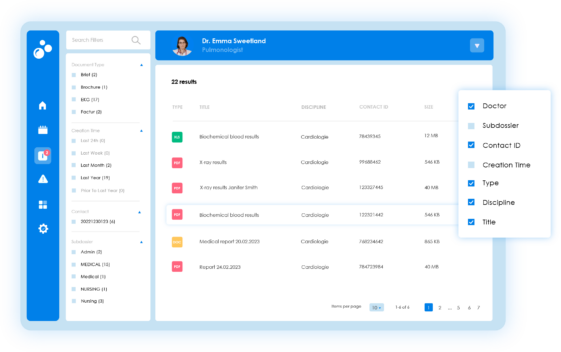
Seamless Access to Retired Application
Leverage the power of sunsetting and carve out strategies to simplify your IT landscape. Ensure seamless access to retired application data, a crucial part of your digital transformation solutions.
Streamline your IT infrastructure through software retirement.
ERP carve-out, CRM Carve-out unnecessary systems and costs.
Retain seamless access to decommissioned application data.
Ensure regulatory compliance with our sunsetting strategies.
" With Docbyte's Application Retirement Solution, we effectively executed our carve out strategy, streamlined our IT systems modernization landscape while ensuring seamless access to retired application data."
Fritz Defloor, CIO of AZ Alma Hospital
Why Docbyte's Application Decommissioning and Retirement Solution Stands Out:
Our robust archiving documentum solution offers comprehensive benefits:
Simplified IT Landscape
Navigate through digital transformation solutions with ease. Carve out complexity by retiring and decommissioning redundant or obsolete applications, while ensuring all critical data remains accessible and usable.
Cost-Efficiency
Reduce maintenance costs associated with sunsetting outdated applications, and redirect resources to areas that drive business growth.
Database System
Even after application decommissioning, ensure seamless access to all data through our intuitive user interface, making it easy to find and retrieve the data you need when you need it.
Regulatory Compliance
Stay in compliance with all relevant regulations, thanks to our solution's comprehensive data management and digital archiving capabilities, perfect for any sunsetting strategy.
Long-Term Data Preservation
Our application retirement solution also provides long-term digital preservation. Safeguard your critical business data by storing it securely in a tamper-proof format that remains accessible and readable for years to come.
Why Choose Our Application Retirement Solution?
Effectively sunset and decommission applications to streamline your IT infrastructure
Features
Sharepoint Preservation
Our SharePoint solution ensures secure, compliant archiving and digital preservation. It automates archiving, manages metadata, and offers advanced search, ensuring long-term access and integrity of your digital assets within a familiar environment.
Automated Retention Management
Automatically applying the correct retention period to archived documents reduces manual intervention. This facilitates compliance and document management.
Intelligent Document Processing
Our solution automates processing contracts, reports, agreements, and other vital documents, reducing employee burnout and minimising errors. Say goodbye to manual document handling and ensure your team stays motivated and accurate.
Format conversion
Enabling seamless transformation of incoming documents to meet your business standards. Whether a document arrives in JPG, PDF, or any other format, it is automatically converted to the specified format required by your organisation, ensuring uniformity and efficiency in document management.
Catalog Integration
Our solution integrates with systems for collection management, maintaining a synchronised view of your archival objects. This ensures that all archival data remains up-to-date and easily accessible, providing a cohesive and organised overview of your stored information.
Secure Cloud Solution
Our document processing system ensures all data is securely stored in the cloud, providing easy accessibility while maintaining top-notch security protocols. This approach facilitates seamless access to documents from anywhere and protects sensitive information against unauthorised access or data loss.
Easy Access and Dissemination
Our solution facilitates the external sharing of information through streamlined dissemination processes. Additionally, it features an easy-to-use access UI, ensuring that users can effortlessly retrieve and share data as needed.
Extensible Plug-In Framework
Integrate the platform via APIs in your existing environment and add a layer of trust to your solutions.
Let us show you
how Docbyte can help
Trusted by Global Businesses Across all Industries
Request a short session with one of our digital archiving specialists and find out which solution works best for you.








